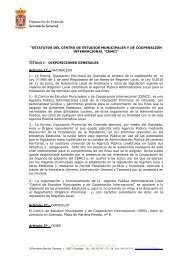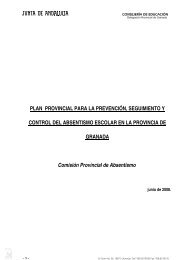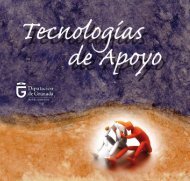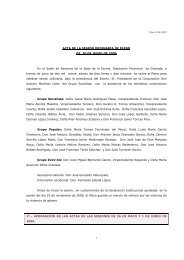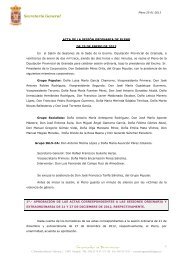manantiales granada_cero.qxp - Diputación de Granada
manantiales granada_cero.qxp - Diputación de Granada
manantiales granada_cero.qxp - Diputación de Granada
You also want an ePaper? Increase the reach of your titles
YUMPU automatically turns print PDFs into web optimized ePapers that Google loves.
<strong>manantiales</strong> <strong>granada</strong>_dos.<strong>qxp</strong> 08/05/2006 15:19 PÆgina 174<br />
GUIA MANANTIALES GRANADA<br />
❖ CORTE HIDROGEOLÓGICO DE LOS MANANTIALES DE VÉLEZ DE BENAUDALLA<br />
la zona también afecta al ámbito hidrogeológico.<br />
La aparición <strong>de</strong> surgencias a distinta<br />
cota pone <strong>de</strong> manifiesto la compartimentación<br />
<strong>de</strong>l macizo.<br />
La recarga total <strong>de</strong>l acuífero se estima en<br />
66 hm 3 /a, <strong>de</strong> los cuales 53 hm 3 /a, correspon<strong>de</strong>n<br />
a infiltración <strong>de</strong>l agua <strong>de</strong> lluvia sobre<br />
los afloramientos permeables y el resto<br />
a aportaciones <strong>de</strong>s<strong>de</strong> el cauce <strong>de</strong>l río Guadalfeo.<br />
Las <strong>de</strong>scargas, equilibradas con la recarga,<br />
tienen lugar, <strong>de</strong> manera más visible a<br />
través <strong>de</strong>l grupo <strong>de</strong> <strong>manantiales</strong> <strong>de</strong> Vélez <strong>de</strong><br />
Benaudalla, con unos 17,3 hm 3 /a <strong>de</strong> caudal<br />
174<br />
El río Guadalfeo contribuye<br />
<strong>de</strong> manera generosa<br />
a la recarga <strong>de</strong>l acuífero<br />
(aproximadamente 550 l/s), otros sectores<br />
arrojan unos 31,5 hm 3 /a (caudal conjunto<br />
<strong>de</strong> 1000 l/s aproximadamente), y, por último,<br />
mediante salidas al cauce <strong>de</strong>l río Guadalfeo<br />
por el sector noreste <strong>de</strong> la unidad,<br />
estimadas en unos 17 hm 3 /a.<br />
Manantiales <strong>de</strong> Vélez <strong>de</strong> Benaudalla<br />
120<br />
80<br />
40<br />
Caudal (l/s) ❖ HIDROGRAMA (Fuente Nueva)<br />
0<br />
1983<br />
1985<br />
1987<br />
1989<br />
1991<br />
Fecha (años)<br />
1993<br />
1995<br />
El análisis químico <strong>de</strong> las aguas (mayo <strong>de</strong> 1992)<br />
indica que son bicarbonatadas cálcico,<br />
con una mineralización débil que<br />
se aproxima a los 500 mg/l. Su temperatura<br />
varía entre media y ligeramente termal (18,7 ºC),<br />
con un pH <strong>de</strong> 7,45.<br />
❖ CARACTERÍSTICAS FÍSICAS (Fuente Nueva)<br />
14<br />
12<br />
10<br />
8<br />
6<br />
4<br />
2<br />
0<br />
pH<br />
60<br />
50<br />
40<br />
30<br />
20<br />
10<br />
0<br />
600<br />
500<br />
400<br />
300<br />
200<br />
100<br />
Tª (ºC) Min (µS/cm)<br />
0<br />
Manantiales <strong>de</strong> Vélez <strong>de</strong> Benaudalla<br />
1997<br />
1999<br />
SO4<br />
(76)<br />
El caudal <strong>de</strong> Fuente Nueva se caracteriza<br />
por presentar un patrón<br />
oscilante, con valores altos seguidos<br />
<strong>de</strong> valores bajos, relacionados<br />
con variaciones en las condiciones<br />
climáticas. El valor máximo se observó<br />
en el año 1998, con un caudal<br />
ligeramente inferior a los 100<br />
l/s. Esto sucedió algo <strong>de</strong>spués <strong>de</strong>l<br />
periodo <strong>de</strong> sequía, entre los años<br />
1993 y 1995, cuando el manantial<br />
llegó a secarse durante un tiempo.<br />
En el resto <strong>de</strong> la serie, su caudal<br />
oscila entre 30 y 80 l/s.<br />
❖ CARACTERÍSTICAS QUÍMICAS (Fuente Nueva)<br />
Cl<br />
(17)<br />
Mg<br />
(42)<br />
HCO3<br />
(277)<br />
Unida<strong>de</strong>s en meq/l<br />
Ca<br />
(154)<br />
175<br />
Na<br />
(8,3)







